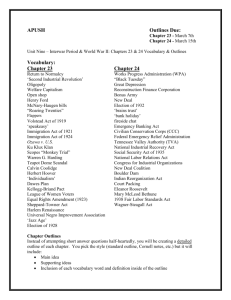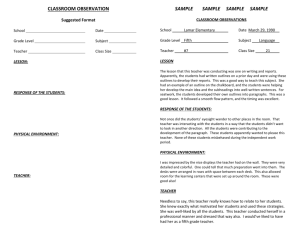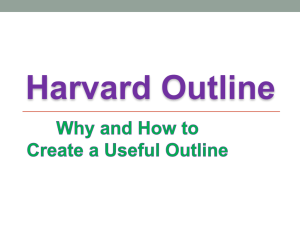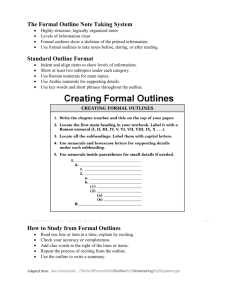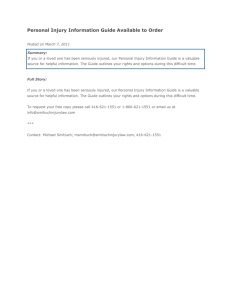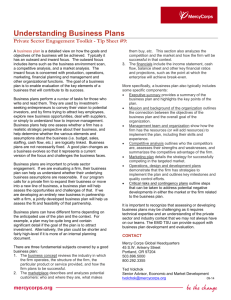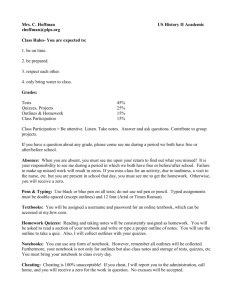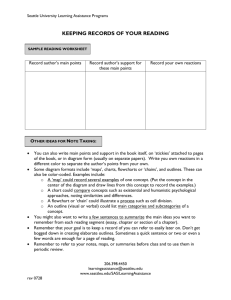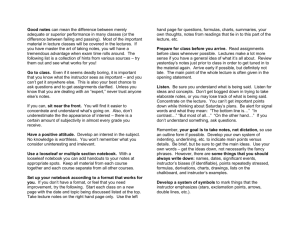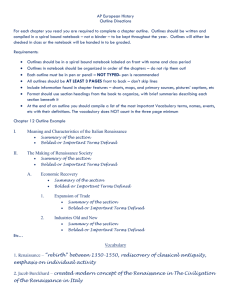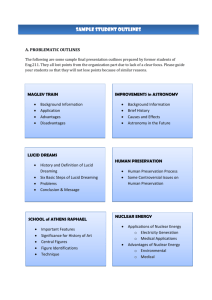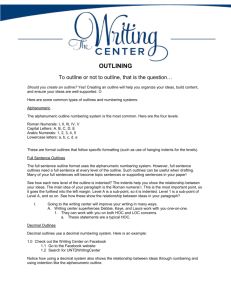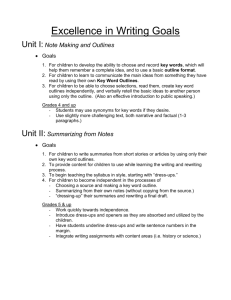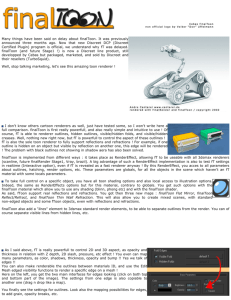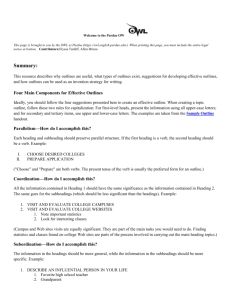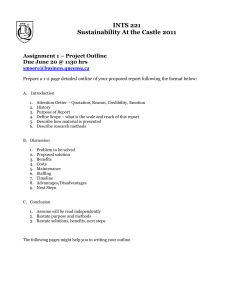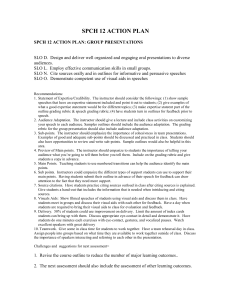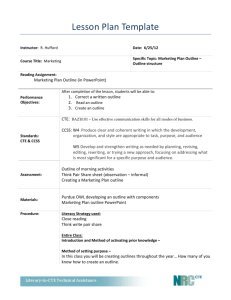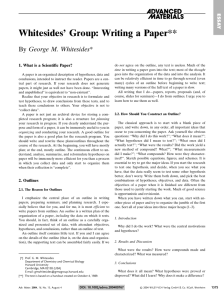HOW TO TAKE NOTES THAT WORK FOR YOU
advertisement
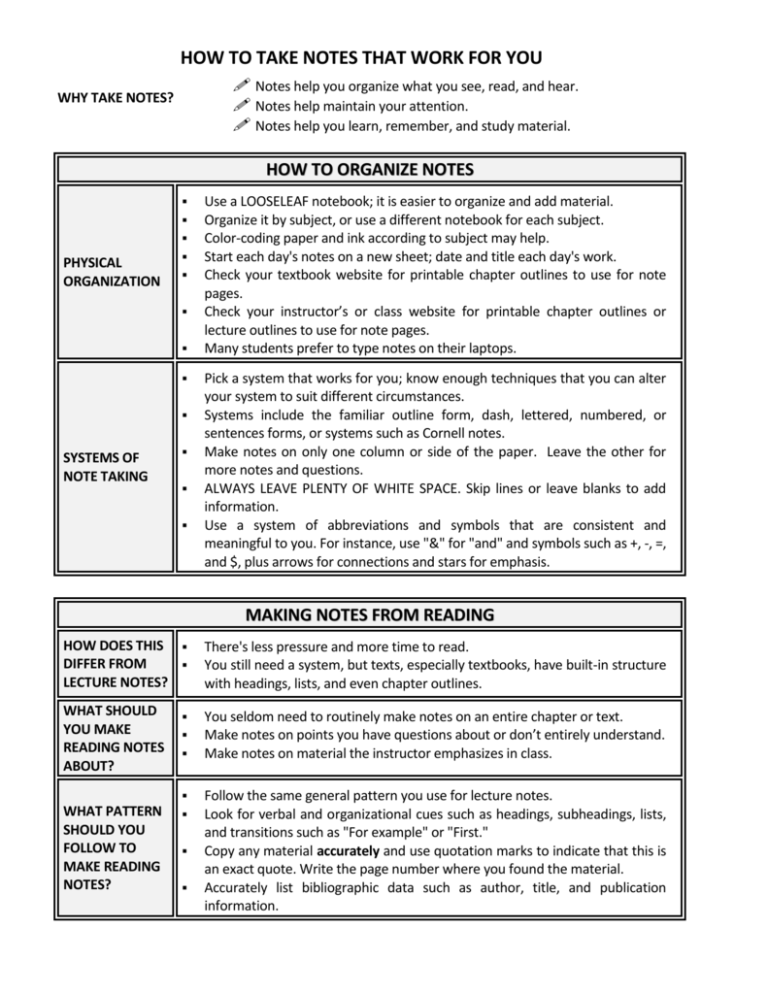
HOW TO TAKE NOTES THAT WORK FOR YOU Notes help you organize what you see, read, and hear. Notes help maintain your attention. Notes help you learn, remember, and study material. WHY TAKE NOTES? HOW TO ORGANIZE NOTES PHYSICAL ORGANIZATION SYSTEMS OF NOTE TAKING Use a LOOSELEAF notebook; it is easier to organize and add material. Organize it by subject, or use a different notebook for each subject. Color-coding paper and ink according to subject may help. Start each day's notes on a new sheet; date and title each day's work. Check your textbook website for printable chapter outlines to use for note pages. Check your instructor’s or class website for printable chapter outlines or lecture outlines to use for note pages. Many students prefer to type notes on their laptops. Pick a system that works for you; know enough techniques that you can alter your system to suit different circumstances. Systems include the familiar outline form, dash, lettered, numbered, or sentences forms, or systems such as Cornell notes. Make notes on only one column or side of the paper. Leave the other for more notes and questions. ALWAYS LEAVE PLENTY OF WHITE SPACE. Skip lines or leave blanks to add information. Use a system of abbreviations and symbols that are consistent and meaningful to you. For instance, use "&" for "and" and symbols such as +, -, =, and $, plus arrows for connections and stars for emphasis. MAKING NOTES FROM READING HOW DOES THIS DIFFER FROM LECTURE NOTES? There's less pressure and more time to read. You still need a system, but texts, especially textbooks, have built-in structure with headings, lists, and even chapter outlines. WHAT SHOULD YOU MAKE READING NOTES ABOUT? You seldom need to routinely make notes on an entire chapter or text. Make notes on points you have questions about or don’t entirely understand. Make notes on material the instructor emphasizes in class. Follow the same general pattern you use for lecture notes. Look for verbal and organizational cues such as headings, subheadings, lists, and transitions such as "For example" or "First." Copy any material accurately and use quotation marks to indicate that this is an exact quote. Write the page number where you found the material. Accurately list bibliographic data such as author, title, and publication information. WHAT PATTERN SHOULD YOU FOLLOW TO MAKE READING NOTES? TAKING LECTURE NOTES BE PREPARED IN CLASS USE GOOD LISTENING SKILLS REVIEW! Read and study before class. Feel positive and motivated; you WANT to learn. Adjust your expectations; lectures are not for entertainment. You have to pay attention. Know what kind of lecture to expect. Will it follow the book? Supplement the book? Cover new material? Have your paper, notebook, and writing utensils ready to go. Instructors may make lecture outlines or presentations available online; textbook websites may have chapter outlines. Print them and make your notes on these already-organized formats. Recording a lecture for a second listening may be helpful. Ask your instructor for permission to do so. Sit where you can see and hear the speaker and audio-visual equipment clearly. Sit up in an attentive posture. Make room on your desk or table. Don't transcribe. It's not possible or necessary to record everything that's said. Listen and begin to understand FIRST, then write. Listen for VERBAL CUES such as "in contrast" or "therefore" or repetition of information. Be alert to PHYSICAL CUES such as gestures or a change in tone of voice. Pay attention to any VISUAL AIDS such as slides, handouts, overheads, problems or examples on the board. Pay attention at the END of a lecture. Speakers sometimes run out of time and cram lots of information in the last few minutes. Ask questions. Briefly review your notes as soon after class as possible. Answer questions, correct errors, fill in blanks, and clarify material on your notes while the lecture is fresh in your mind. Follow up by further reading or asking questions in the next class. © 2010 Teaching/Learning Center, Delta College, University Center, MI 48710
